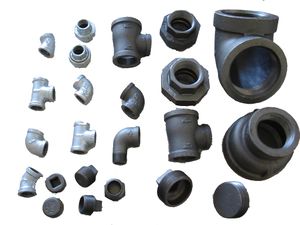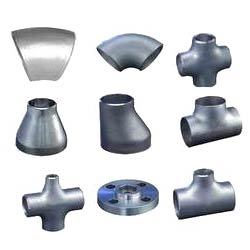|
|
| (One intermediate revision by the same user not shown) |
| Line 2: |
Line 2: |
| [[File:Pipe fittings.jpg|thumb|right|Pipe Fittings]] | | [[File:Pipe fittings.jpg|thumb|right|Pipe Fittings]] |
| [[File:PIPE FITTINGS1.jpg|thumb|right|Pipe Fittings]] | | [[File:PIPE FITTINGS1.jpg|thumb|right|Pipe Fittings]] |
| '''Pipe Fitting''' is the occupation of installing or repairing piping or tubing systems that convey liquid, gas, and occasionally solid materials. This work involves selecting and preparing pipe or tubing, joining it together by various means, and the location and repair of leaks. | | '''Pipe Fitting''' is used in pipe plumbing systems to connect straight pipe or tubing sections, to adapt to different sizes or shapes, and for other purposes, such as regulating or measuring fluid flow. The term plumbing is generally used to describe conveyance of water, gas, or liquid waste in ordinary domestic or commercial environments, whereas piping is often used to describe high-performance conveyance of fluids in specialized applications. The term tubing is sometimes used for lighter-weight piping, especially types that are flexible enough to be supplied in coiled form. |
|
| |
|
| Pipe fitting work is done in many different settings: HVAC, manufacturing, hydraulics, refineries, nuclear-powered super carriers and fast attack submarines computer chip fab plants, power plant construction and other steam systems. Pipe fitters sometimes called simply fitters are represented in the USA and Canada by the United Association of Journeymen and Apprentices of the Plumbing and Pipe Fitting Industry of the United States and Canada. | | Pipe fittings require money, time, materials, and tools to install, so they are a non-trivial part of piping and plumbing systems. [[Valves]] are technically fittings, but are usually discussed separately. |
| | |
| Fitters work with a variety of pipe and tubing materials including several types of steel, copper, iron, aluminium, and plastic. Pipe fitting is not plumbing; the two are related but separate trades. Pipe fitters who specialize in fire prevention are called sprinkler fitters, another related, but separate trade.Materials, techniques, and usages vary from country to country as different nations have different standards to install pipe.
| |
| | |
| | |
| | |
| | |
| ==Copper pipe==
| |
| Copper tubing is most often used for supply of hot and cold water, and as refrigerant line in HVAC systems. There are two basic types of copper tubing, soft copper and rigid copper. Copper tubing is joined using flare connection, compression connection, or solder. Copper offers a high level of resistance to corrosion, but is becoming very costly.
| |
| | |
| ===Soft copper===
| |
| Soft or ductile copper tubing can be bent easily to travel around obstacles in the path of the tubing. While the work hardening of the drawing process used to size the tubing makes the copper hard or rigid, it is carefully annealed to make it soft again; it is therefore more expensive to produce than non-annealed, rigid copper tubing. It can be joined by any of the three methods used for rigid copper, and it is the only type of copper tubing suitable for flare connections. Soft copper is the most popular choice for refrigerant lines in split-system air conditioners and heat pumps.
| |
| | |
| ===Flare connections===
| |
| Flare connections require that the end of a tubing section be spread outward in a bell shape using a flare tool. A flare nut then compresses this bell-shaped end onto a male fitting. Flare connections are a labor intensive method of making connections, but are quite reliable over the course of many years.
| |
| | |
| ===Rigid copper===
| |
| Rigid copper is a popular choice for water lines. It is joined using a sweat, compression or crimped or pressed connection. Rigid copper, rigid due to the work hardening of the drawing process, cannot be bent and must use elbow fittings to go around corners or around obstacles. If heated and allowed to slowly cool, called annealing, then rigid copper will become soft and can be bent or formed without cracking.
| |
| | |
| ===Soldered connections===
| |
| Solder fittings are smooth, and easily slip onto the end of a tubing section. The joint is then heated using a torch, and solder is melted into the connection. When the solder cools, it forms a very strong bond which can last for decades. Solder-connected rigid copper is the most popular choice for water supply lines in modern buildings. In situations where many connections must be made at once such as plumbing of a new building, solder offers much quicker and much less expensive joinery than compression or flare fittings. The term sweating is sometimes used to describe the process of soldering pipes.
| |
| | |
| ===Compression connections===
| |
| Compression fittings use a soft metal or thermoplastic ring which is squeezed onto the pipe and into the fitting by a compression nut. The soft metal conforms to the surface of the tubing and the fitting, and creates a seal. Compression connections do not typically have the long life that sweat connections offer, but are advantageous in many cases because they are easy to make using basic tools. A disadvantage in compression connections is that they take longer to make than sweat, and sometimes require retightening over time to stop leaks.
| |
| | |
| ===Crimped or pressed connections===
| |
| Crimped or pressed connections use special copper fittings which are permanently attached to rigid copper tubing with a powered crimper. The special fittings, manufactured with sealant already inside, slide over the tubing to be connected. Thousands of pounds-force per square inch of pressure are used to deform the fitting and compress the sealant against the inner copper tubing, creating a water tight seal. The advantages of this method are that it should last as long as the tubing, it takes less time to complete than other methods, it is cleaner in both appearance and the materials used to make the connection, and no open flame is used during the connection process. The disadvantages are that the fittings used are harder to find and cost significantly more than sweat type fittings.
| |
| | |
| | |
| | |
| | |
| ==Aluminium pipe==
| |
| Aluminium is sometimes used due to its low cost, resistance to corrosion and solvents, and its ductility. Aluminium tube is more desirable than steel for the conveyance of flammable solvents, since it cannot create sparks when manipulated. Aluminium tubing can be connected by flare or compression fittings, or it can be welded by the TIG or heliarc processes.
| |
| | |
| | |
| | |
| | |
| ==Glass pipe==
| |
| Tempered glass pipes are used for specialized applications, such as corrosive liquids, medical or laboratory wastes, or pharmaceutical manufacturing. Connections are generally made using specialized gasket or O-ring fittings.
| |
|
| |
|
|
| |
|
| Line 48: |
Line 10: |
|
| |
|
| ==Sources== | | ==Sources== |
| [http://en.wikipedia.org/wiki/Pipe_fitting Wikipedia Pipe fitting] | | [http://en.wikipedia.org/wiki/Piping_and_plumbing_fittings Wikipedia Pipe fitting] |
Pipe Fitting is used in pipe plumbing systems to connect straight pipe or tubing sections, to adapt to different sizes or shapes, and for other purposes, such as regulating or measuring fluid flow. The term plumbing is generally used to describe conveyance of water, gas, or liquid waste in ordinary domestic or commercial environments, whereas piping is often used to describe high-performance conveyance of fluids in specialized applications. The term tubing is sometimes used for lighter-weight piping, especially types that are flexible enough to be supplied in coiled form.
Pipe fittings require money, time, materials, and tools to install, so they are a non-trivial part of piping and plumbing systems. Valves are technically fittings, but are usually discussed separately.
Sources
Wikipedia Pipe fitting

